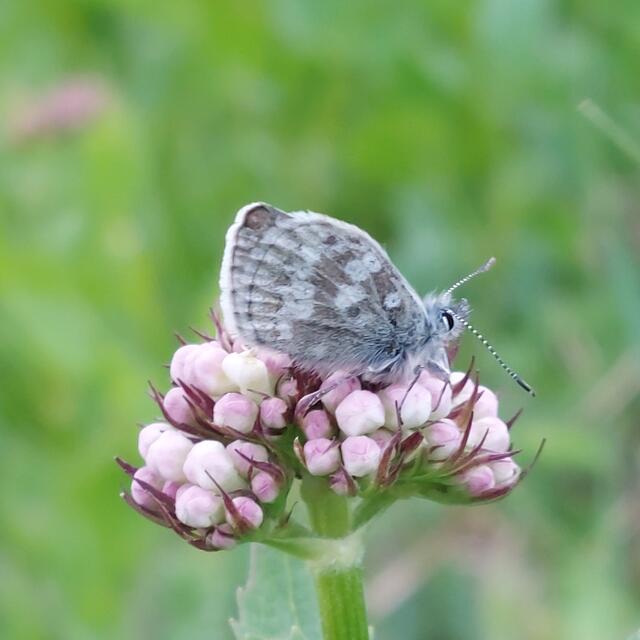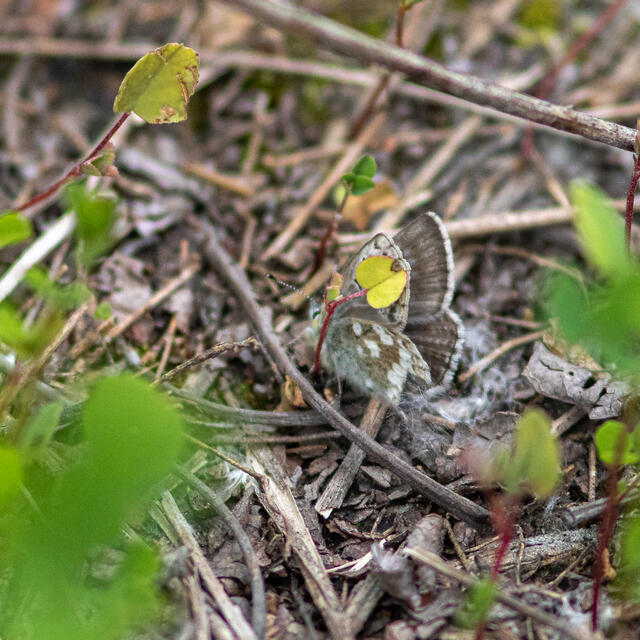Arctic Blue
Plebejus glandon (de Prunner, 1798)
Family: Lycaenidae
Subfamily: Polyommatinae
Identification: Geographically variable. Upperside of male gray-blue, female orange-brown; both sexes with dark cell spots on both wings. Underside hindwing with postmedian black spots lacking or enclosed by white patches.
Wing Span: 7/8 - 1 inches (2.2 - 2.6 cm).
Life History: Eggs are laid singly on leaves, bracts, or sepals of the host plant. Caterpillars or chrysalids hibernate.
Flight: One brood from early May to late September, mainly June-August.
Caterpillar Hosts: Possibly Diapensia lapponica, Dodecatheon, and Androsace septentionalis.
Adult Food: Flower nectar.
Habitat: Bogs, tundra, gravelly hills, alpine fell-fields, and subalpine meadows.
Range: Holarctic. Alaska east to Newfoundland, south through the mountains of the West to Washington, northern Arizona, and northern New Mexico.
Conservation: Not usually of conservation concern.
NCGR: G5 - Demonstrably secure globally, though it may be quite rare in parts of its range, especially at the periphery.
Management Needs: Study conservation needs and implement if necessary.
BAMONA Shop
Please donate!
We depend on donations to keep Butterflies and Moths of North America freely available. We want to express our gratitude to all who showed their support by making a contribution this year. You can donate to support this project at any time.
Advertise with us!
Do you have a product or service that you think would interest BAMONA users? If you would like to advertise on this website, contact us by email, or use the contact form and select the "Advertising" category.
Verified Sightings
Displaying 1 - 24 of 282 verified sightings

Observation date: Jun 15, 2025
Submitted by: DayBC
Region: Newfoundland and Labrador, Canada
Verified by: jwileyrains
Verified date: Aug 21, 2025

Observation date: Aug 06, 2025
Submitted by: Cactuswren1976
Region: Santa Fe County, New Mexico, United States
Verified by: stevecary
Verified date: Aug 09, 2025

Observation date: Jul 20, 2025
Submitted by: NikkiM
Region: Carbon County, Montana, United States
Verified by: J_Martineau
Verified date: Jul 27, 2025

Observation date: Jul 17, 2025
Submitted by: regina rochefort
Region: Skagit County, Washington, United States
Verified by: davidwdroppers
Verified date: Jul 20, 2025

Observation date: Jun 20, 2025
Submitted by: topper72
Region: Los Alamos County, New Mexico, United States
Verified by: stevecary
Verified date: Jun 22, 2025

Observation date: Jul 07, 2024
Submitted by: Joshua C
Region: Taos County, New Mexico, United States
Verified by: stevecary
Verified date: Apr 14, 2025

Observation date: Jun 25, 2024
Submitted by: Joshua C
Region: Los Alamos County, New Mexico, United States
Verified by: stevecary
Verified date: Feb 28, 2025

Observation date: Sep 02, 2024
Submitted by: NikkiM
Region: Carbon County, Montana, United States
Verified by: J_Martineau
Verified date: Sep 05, 2024

Observation date: Jul 28, 2024
Submitted by: ncrosbyrd
Region: Carbon County, Montana, United States
Verified by: J_Martineau
Verified date: Sep 04, 2024

Observation date: Aug 01, 2024
Submitted by: Reneerob17
Region: San Miguel County, New Mexico, United States
Verified by: stevecary
Verified date: Aug 05, 2024

Observation date: Jul 13, 2024
Submitted by: Cactuswren1976
Region: Taos County, New Mexico, United States
Verified by: stevecary
Verified date: Jul 16, 2024

Observation date: Jun 25, 2024
Submitted by: topper72
Region: Los Alamos County, New Mexico, United States
Verified by: stevecary
Verified date: Jun 29, 2024

Observation date: Jun 14, 2024
Submitted by: dsperanza
Region: Montana, United States
Verified by: J_Martineau
Verified date: Jun 18, 2024

Observation date: Jul 15, 2023
Submitted by: Joshua C
Region: Bernalillo County, New Mexico, United States
Verified by: stevecary
Verified date: Jul 31, 2023

Observation date: Jul 18, 2023
Submitted by: regina rochefort
Region: Skagit County, Washington, United States
Verified by: davidwdroppers
Verified date: Jul 20, 2023

Observation date: Jul 09, 2023
Submitted by: tjay13
Region: Santa Fe County, New Mexico, United States
Verified by: stevecary
Verified date: Jul 12, 2023

Observation date: Jul 06, 2023
Submitted by: regina rochefort
Region: Skagit County, Washington, United States
Verified by: davidwdroppers
Verified date: Jul 09, 2023

Observation date: Jul 07, 2023
Submitted by: weflybye
Region: Jefferson County, Washington, United States
Verified by: davidwdroppers
Verified date: Jul 08, 2023

Observation date: Jul 10, 2018
Submitted by: Cheri Phillips
Region: Larimer County, Colorado, United States
Verified by: mikefisher
Verified date: May 29, 2023

Observation date: Jul 20, 2022
Submitted by: Pheasantboy77
Region: Gallatin County, Montana, United States
Verified by: stevekohler
Verified date: Apr 24, 2023

Observation date: Jul 20, 2022
Submitted by: Pheasantboy77
Region: Gallatin County, Montana, United States
Verified by: stevekohler
Verified date: Apr 24, 2023

Observation date: Jul 05, 2021
Submitted by: frogbandit
Region: Anchorage, Alaska, United States
Verified by: Paul Prappas
Verified date: Feb 11, 2023

Observation date: Jul 01, 2020
Submitted by: jsaunders260
Region: Matanuska-Susitna, Alaska, United States
Verified by: Paul Prappas
Verified date: Feb 07, 2023

Observation date: Jul 02, 2020
Submitted by: Rick Sinnott
Region: Anchorage, Alaska, United States
Verified by: Paul Prappas
Verified date: Feb 07, 2023
- 1 of 12
- next ›







